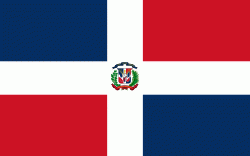Constanza (Constanza)
Constanza is a town and municipality in La Vega Province, Dominican Republic. Located in the Cordillera Central region, Constanza is known for having the coldest temperature for a settlement on the island of Hispaniola, as well as the entire Caribbean. It is also the Dominican Republic's highest settlement; however, it is not the highest settlement on Hispaniola, as Kenscoff in Haiti is slightly higher in elevation, at 1,504 m (4836 ft).
The name of Constanza has its origin in the legend the daughter of a local Taíno chief who lived in the valley. Constanza was a sparsely populated area, though several explorers knew the valley in colonial times, and there was a settler named Victoriano Velano who brought European agriculture and ranching culture to the area in 1750.
In 1852, the German-British explorer and consul Sir Robert Hermann Schomburgk mentions the existence of a farm in the valley of Constanza. The town was formally founded in 1894. It was incorporated into a municipality in La Vega Province on September 9, 1907.
On June 14, 1959, a plane landed on an Constanza airstrip with more than forty Cuban-trained rebels, with the purpose of killing the then-dictator Rafael Trujillo. They fought guerrilla warfare in the nearby mountains against the Dominican Army for two months before the armed forces managed to end the rebellion.
The name of Constanza has its origin in the legend the daughter of a local Taíno chief who lived in the valley. Constanza was a sparsely populated area, though several explorers knew the valley in colonial times, and there was a settler named Victoriano Velano who brought European agriculture and ranching culture to the area in 1750.
In 1852, the German-British explorer and consul Sir Robert Hermann Schomburgk mentions the existence of a farm in the valley of Constanza. The town was formally founded in 1894. It was incorporated into a municipality in La Vega Province on September 9, 1907.
On June 14, 1959, a plane landed on an Constanza airstrip with more than forty Cuban-trained rebels, with the purpose of killing the then-dictator Rafael Trujillo. They fought guerrilla warfare in the nearby mountains against the Dominican Army for two months before the armed forces managed to end the rebellion.
Map - Constanza (Constanza)
Map
Country - Dominican_Republic
 |
 |
| Flag of the Dominican Republic | |
The native Taíno people had inhabited Hispaniola before the arrival of Europeans, dividing it into five chiefdoms. They had constructed an advanced farming and hunting society, and were in the process of becoming an organized civilization. The Taínos also inhabited Cuba, Jamaica, Puerto Rico, and the Bahamas. The Genoese mariner Christopher Columbus explored and claimed the island for Castile, landing there on his first voyage in 1492. The colony of Santo Domingo became the site of the first permanent European settlement in the Americas and the first seat of Spanish colonial rule in the New World. It would also become the site to introduce importations of enslaved Africans to the Americas. In 1697, Spain recognized French dominion over the western third of the island, which became the independent state of Haiti in 1804.
Currency / Language
| ISO | Currency | Symbol | Significant figures |
|---|---|---|---|
| DOP | Dominican peso | $ | 2 |
| ISO | Language |
|---|---|
| ES | Spanish language |















